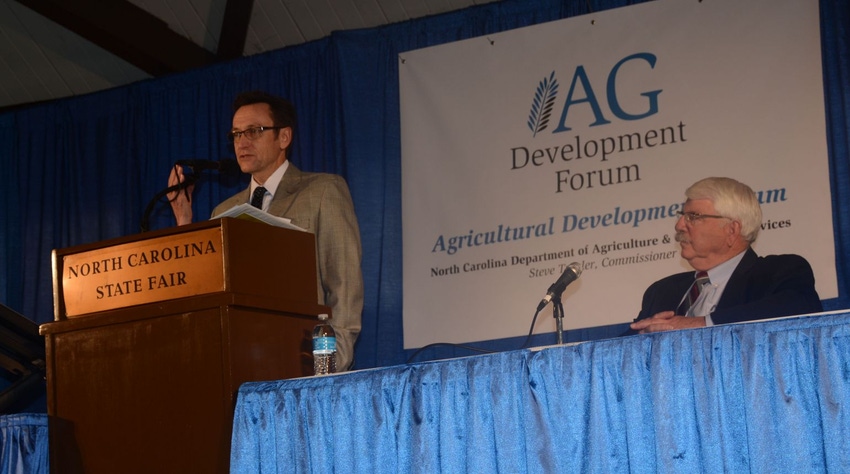
Large supplies of crops and livestock and subdued demand will mean low prices again this year, but there is hope for recovery in 2018.
So says Blake Brown, Hugh C. Kiger professor and Extension economist at North Carolina State University, speaking at this year’s Ag Development Forum at the Southern Farm Show in Raleigh Feb. 2.
“We have big supplies in most areas right now,” Brown said. “This will make for continued downward pressure on a lot of commodity prices this year, but hopefully we’ll get through this year and get back in balance the coming year.”
In 2015 (the 2016 number aren’t available yet), North Carolina had net farm receipts of $11.6 billion. Of that figure, $7.96 billion or 68 percent came from the livestock sector, with chickens, broilers and hogs the biggest segment. Crops represent the rest of the figure at $3.68 billion in 2015. Both crops and livestock are vital to the North Carolina economy, Brown said.
This year will be another year of large supplies in both hogs and poultry. The cow herd is way up and cattle prices are also down. The bright spot for livestock producers is that feed prices are also down. “That’s not good news for crop farmers, but it is good news for cattle feeders and for the hog industry and poultry industry,” Brown said.
Corn prices are below $4 per bushel, but Brown noted that North Carolina is a corn deficit state which means North Carolina corn producers earn a good basis on their corn so corn prices in the state are closer to $4 per bushel.
Brown said the story for cotton is much he same as livestock, corn and soybeans: large supplies and very large ending stocks. However, cotton’s problems go beyond large supplies and big stocks: cheap oil means lower polyester prices, which means developing countries are switching to polyester at the expense of cotton.
“There’s nothing new about that and it is happening now, but the other issue is the really high tech manmade fibers that are out there now. The polyester of today is very high tech with some incredible fabrics. In developed countries, where price doesn’t matter that much, that’s really taking a substantial share away from cotton,” Brown said.
Cotton needs another technological leap, such as wrinkle-free cotton in the 1980s, to compete with polyester, Brown said. “Until that happens, I’m afraid we’re going to deal with a difficult situation in cotton."
Brown called sweet potatoes the success story in North Carolina agriculture due in large part to efforts by the North Carolina Sweet Potato Growers Association in promoting the crop in the United States and Europe. Sweet potato consumption is goring up substantially, a trend Brown says will continue.
Brown points out that sweet potato acreage was up in 2016, which meant supply moved a bit ahead of demand. “Prices aren’t horrible but they are down. There are still positive returns over operating costs,” he said.
About the Author(s)
You May Also Like






